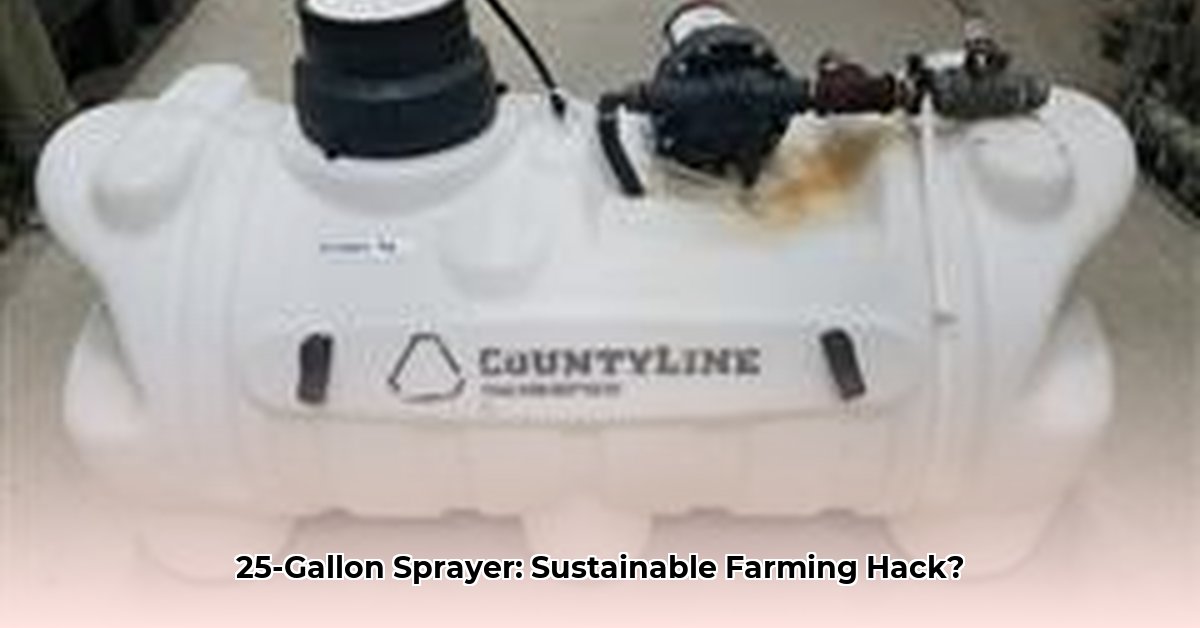
Understanding Your 25-Gallon Sprayer
Before embarking on your sustainable spraying journey, familiarize yourself with your Tractor Supply 25-gallon sprayer. Carefully examine its components: the tank, pump, wand, and nozzles. Understanding how to adjust nozzle pressure to achieve the desired spray pattern is crucial for efficient and targeted application. Always consult the manufacturer's manual for detailed instructions and safety precautions. Investing time in understanding your equipment's features will significantly improve your spraying efficiency. For more sprayer information, check out these helpful sprayer resources.
Preparing for Efficient and Sustainable Spraying
Effective and environmentally responsible spraying begins before you even turn on the sprayer. Thorough planning is paramount for minimizing chemical use and maximizing results.
1. Targeted Application (Spot Spraying): Precisely identify areas needing treatment. Spot spraying, a cornerstone of sustainable agriculture, ensures chemicals are applied only where necessary, reducing overall chemical usage and environmental impact. This precision approach leads to significant cost savings while protecting non-target areas.
2. Selecting the Appropriate Solution: Choose the correct product for your specific needs, carefully reviewing the label for application instructions and compatibility with your sprayer. Prioritize environmentally friendly options whenever possible. Always ensure compatibility to avoid damaging the sprayer components. Incorrect product selection can lead to ineffective treatment or sprayer damage.
3. Accurate Mixing: Follow the product label's mixing instructions meticulously. Precise mixing is essential for optimal efficacy and safety. Never deviate from the recommended ratios. Inaccurate mixing can compromise the effectiveness of the treatment or lead to unintended consequences.
4. Pre-Sprayer Inspection: Before filling the tank, thoroughly inspect the sprayer for leaks, worn parts, and nozzle functionality. A well-maintained sprayer guarantees a consistent spray pattern, minimizing waste and ensuring even treatment. Neglecting this crucial step can lead to uneven application and chemical waste.
5. Filling and Priming: Carefully fill the tank, preventing spills. Prime the pump to eliminate air bubbles that could obstruct the system and result in uneven spraying. Air bubbles can lead to inconsistent application rates and reduced efficacy.
6. Calibration for Precision: Calibrating your sprayer ensures the precise application of the solution per unit area (e.g., per acre). This step is critical to avoid over-application and waste, ensuring both cost-effectiveness and environmental responsibility. Numerous online resources provide detailed calibration methods.
7. Practice Run: Before spraying your crops, practice on a small, insignificant area to get accustomed to the sprayer and refine your spray pattern. Testing ensures confidence and prevents accidental damage to valued plants.
8. Personal Protective Equipment (PPE): Always wear appropriate PPE, including gloves, goggles, and a respirator when working with chemicals. Safety is non-negotiable. Protecting your health is paramount.
Sustainable Spraying Best Practices: Maximizing Efficiency and Minimizing Impact
Spot spraying with a 25-gallon sprayer is transformative for sustainable agriculture. By precisely targeting weeds and pests, you significantly reduce chemical usage. This minimizes environmental impact and optimizes cost-effectiveness. However, maintaining precision in application is critical to avoid unintended consequences. Improper techniques can negate the benefits of spot spraying.
Maintaining Your Sprayer for Longevity and Optimal Performance
Regular maintenance is crucial for extending the life of your sprayer and ensuring its continued effectiveness.
| Maintenance Task | Frequency | Benefits |
|---|---|---|
| Thorough Cleaning | After each use | Prevents clogs, corrosion, and maintains accuracy of future applications. |
| Leak Detection | Before each use | Prevents chemical spills and ensures consistent performance. |
| Pump Pressure Check | Before each use | Ensures uniform spraying and prevents under or over-application. |
| Nozzle Inspection/Cleaning | As needed | Ensures a precise spray pattern and prevents uneven coverage. |
| Winterization (if needed) | End of growing season | Protects against freezing temperatures and damage during off-season storage. |
Mastering your 25-gallon sprayer requires practice and attention to detail. Don't be disheartened by initial imperfections. Consistent practice will transform you into a more efficient and sustainable farmer.
Minimizing Pesticide Drift: A Crucial Aspect of Sustainable Spraying
Dr. Emily Carter, Agricultural Extension Specialist at the University of California, Davis, emphasizes, "Understanding pesticide drift is paramount for responsible agricultural practices. Drift significantly impacts environmental health and reduces the efficacy of your pesticide application." Proper sprayer selection, technique, and environmental awareness are pivotal in minimizing drift and achieving sustainable outcomes.
Key Considerations for Minimizing Drift:
- Nozzle Selection: Larger droplets are less prone to drift than smaller ones.
- Pressure Control: Higher pressure increases drift potential; find the optimal balance.
- Wind Conditions: Spray only under low-wind conditions. Early mornings or late evenings are often ideal.
- Application Height: Maintain an appropriate height above the target area.
- Environmental Factors: Temperature and humidity influence evaporation rates and drift.
- Buffer Zones: Establish buffer zones around target areas to prevent drift to non-target areas.
- Record Keeping: Maintain detailed records of applications for future reference and compliance.
Remember, responsible pesticide application is a key aspect of sustainable farming. Consistent effort in these areas will result in positive environmental and agricultural outcomes.